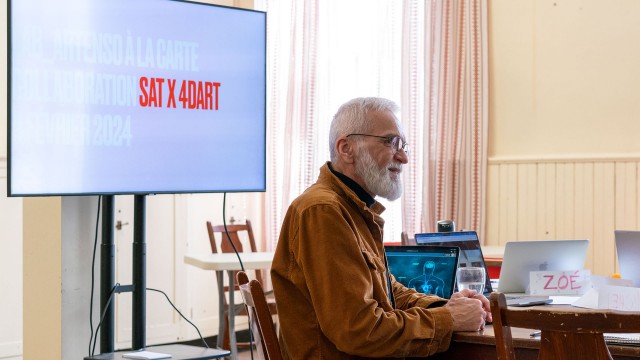The 4D ART Cavern according to Michel Lemieux
How does this project differ from other 4D ART creations?
The cavern is a virtual gallery project totally different from anything we've done at 4D ART since our company was founded. After the recent creation of three VR films by our team, we were able to build up the first steps of a permanent collection; we needed a place to gather them all together and present them. This virtual gallery has been imagined and thought out as if it were a real/physical place, with its own touring and mediation mechanisms, but which unfolds in the virtual world.
What makes the cavern different from other virtual galleries already found online?
Many of the virtual galleries currently available online are exact replicas of the real thing. We find the classic art gallery design, often white and rather cold. For the 4D ART Cavern, we tried to develop an aesthetic that was both mineral and mythological, to reinforce the fact that this is not a real place, but a virtual one. For us, it becomes interesting to transcend the real with the mythological aspect of the cave : Plato's allegory. For us, it's a reference to the beginnings of art, cinema as well as virtual and augmented reality.
Who do you think will be interested in this project?
Naturally, the 4D ART Cavern will be of particular interest to young audiences, because digital technology is a medium that appeals to them a lot: the dematerialization of places, the possibility of visiting art galleries from anywhere, is of great interest to them. So the in-school mediation activities linked to the cavern that we've begun developing is a natural fit.
I believe that through its multi-platform accessibility, on mobile, desktop, and even with VR headset, the cavern will be able to attract different audiences of all ages who are interested in art and new technologies, which is really the rallying point of 4D ART.
What's your reaction to the results of the beta tests with high school students?
Following the beta tests with the students, we were particularly impressed by their comments. The observations they made weren't strictly technological in nature. Young people are already fully at home in this world: they know how to control and move around in virtual spaces similar to video games. Their questions related much more to the works presented in the cavern, to the themes addressed in 4D ART's VR films. It gives us hope that humanity isn't just heading for superficiality. There's still a certain desire to go deeper artistically and intellectually, to reflect on the human condition, philosophy and our relationship with technology.
What skills did the 4D ART team gain from working with SAT on this project?
4D ART's collaboration with SAT on this project was extremely instructive. For us, it provided a wealth of information on the technology needed to create a virtual gallery. SAT guided us in their approach to mediation, and pushed us to enter into conversation with the people who experience the work, which leads us towards our new mission. For decades, 4D ART has been addressing different audiences, whether in theaters, museums, artist-run centers and so on. The 4D ART Cavern now takes us into a more open environment of exchange, conversation and collaboration. And that's just what the school environment needs.
Personally, as artistic director of the 4D ART Cavern, I've learned a lot from this project, and I humbly believe that the other members of our team have also benefited technologically from this collaboration with the formidable SAT team.
How do you see this collaboration continuing?
The 4D ART Cavern opens a whole new world of opportunities for wider distribution, even though the gallery is virtual. An extremely eco-responsible form of distribution that will enable different audiences to experience our work in a fairly controlled context. Instead of putting our work on display in other virtual galleries, we're putting it inside our own. The strategy of openness will continue, with new artists creating works specifically for the cavern, in some cases, and existing works being exhibited there.
Another objective is to promote mediation. When you go to the theater, it's more difficult to talk about the play collectively. In the Caverne 4D ART, you can visit the gallery as a group, choose a virtual work and discuss it together for as long as you like. It's quite unique! The interface we've created for mediation is really user-friendly, and will enable us to set ourselves up as an alternative to the various virtual meeting platforms, such as Zoom or TEAMS, and proposes an approach to mediation that is more natural, and may perhaps encourage us to discuss more naturally, allowing us to go into greater depth in our discourse.
The other great thing about the 4D ART Cavern is that it can expand. We'll be able to add alcoves or new rooms for works by 4D ART or guest artists, while retaining the artistic direction of the cavern. We also want to add doors in the stone walls that will connect us to other virtual galleries. We can imagine corridors of doors, which would enable us to create a network of virtual galleries, in a two-way sense of course, and allow this action to become much larger and more significant.


